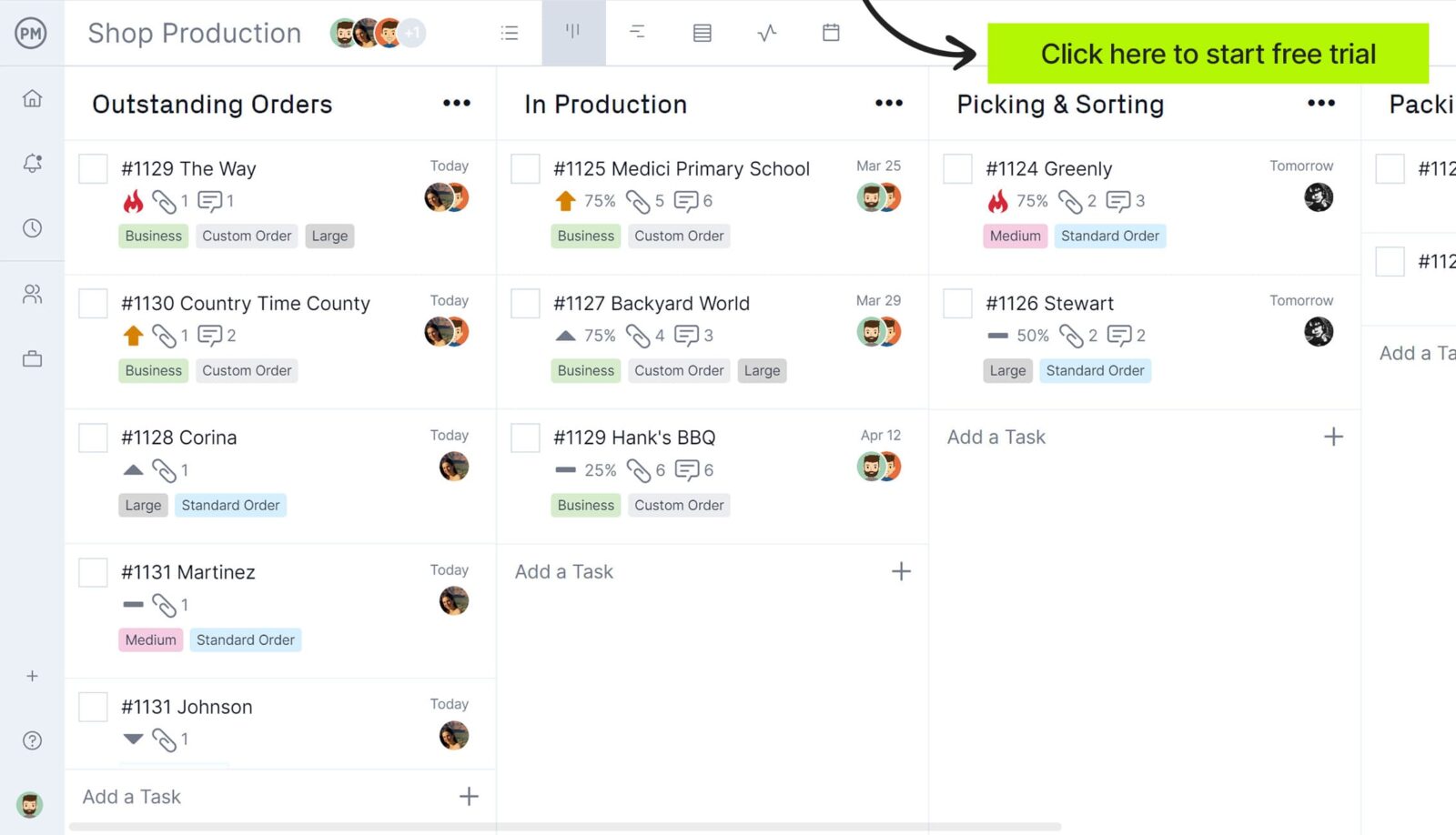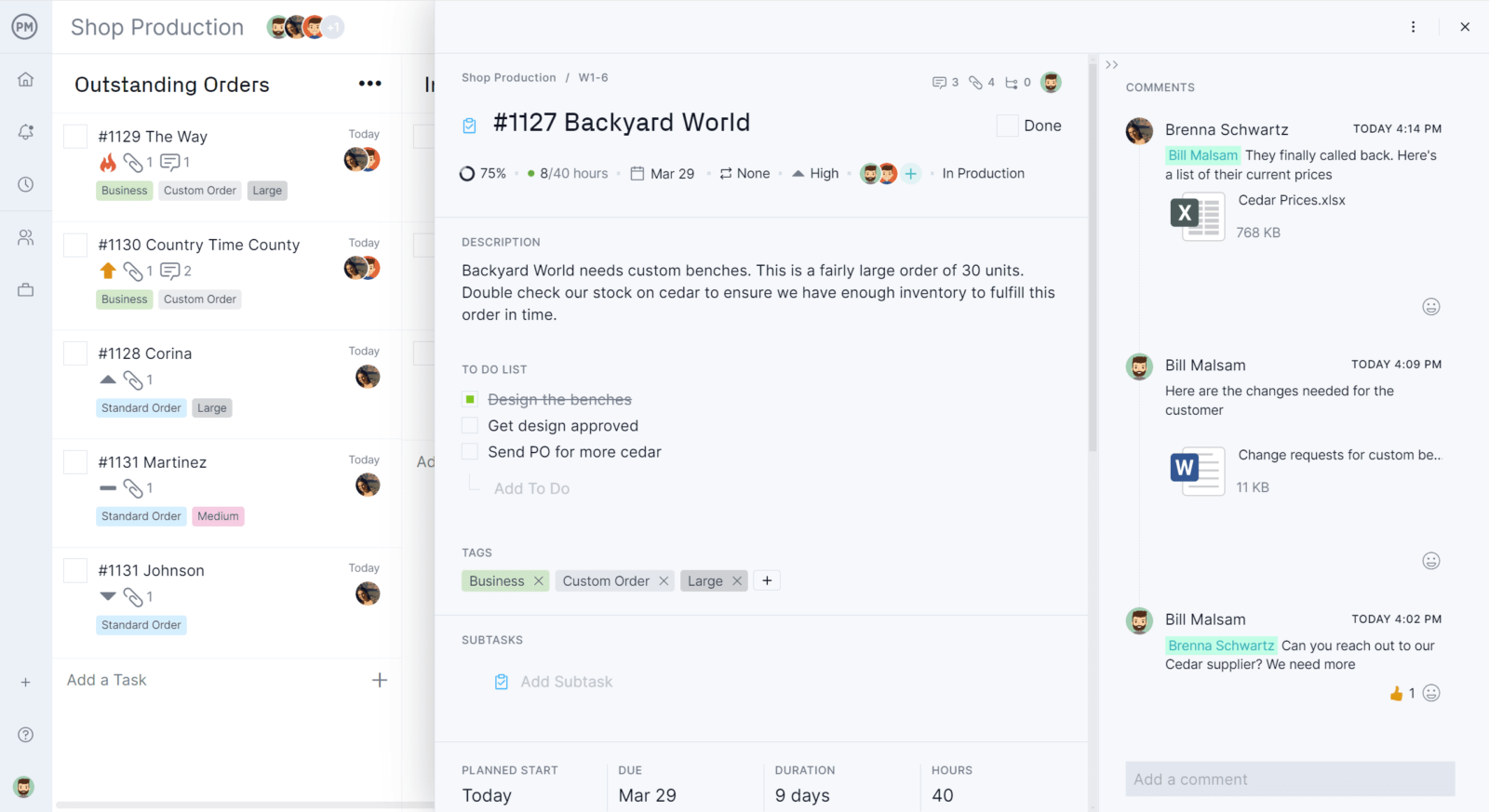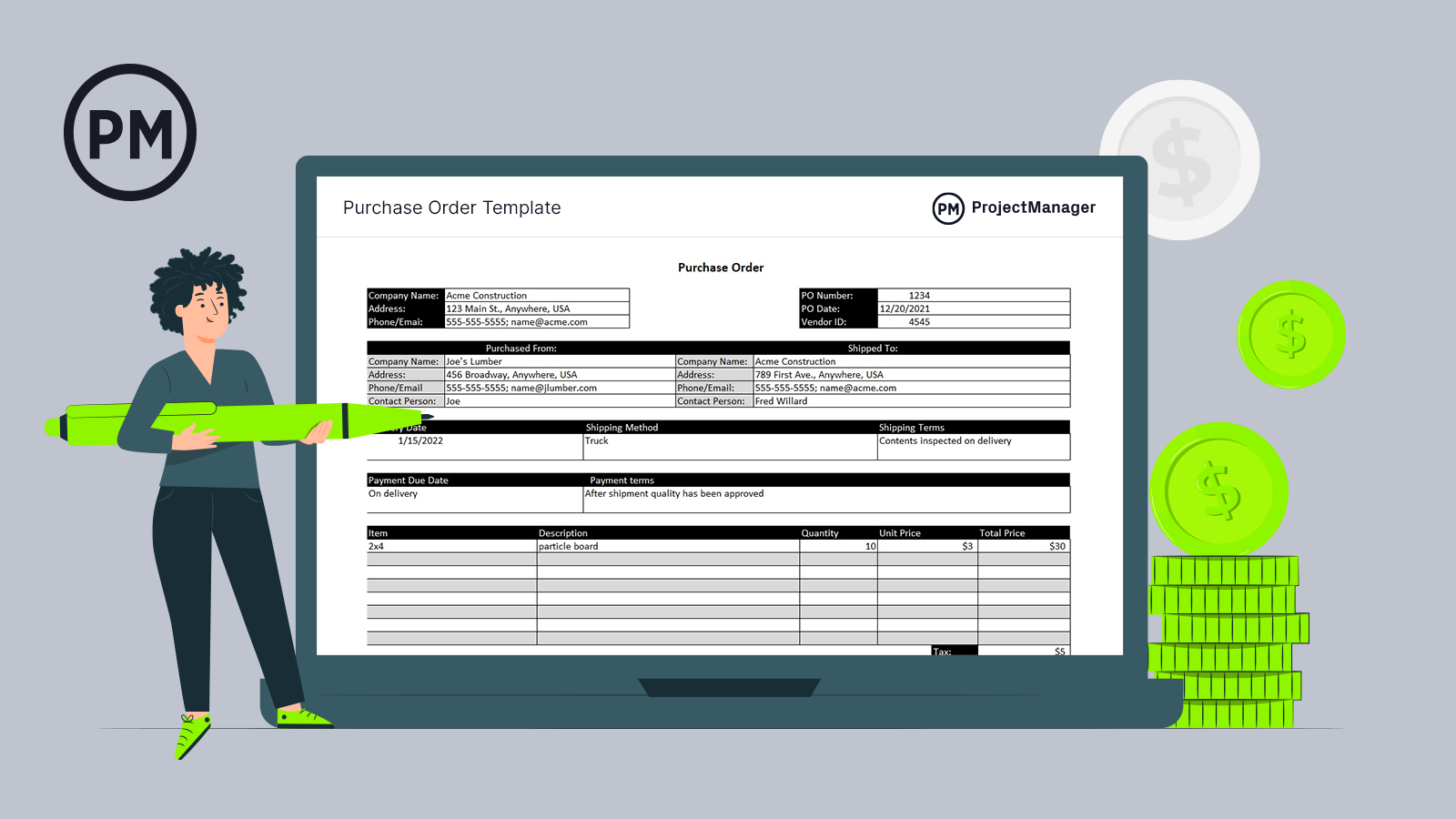Projects often require sourcing products and services from external organizations. To streamline the process, you’ll need an effective purchase order pipeline. Thorough purchase orders reduce confusion and provide a paper trail for legal purposes should issues arise.
Download our purchase order template to start this process on the right foot—all you’ll need to do is fill in the blanks.
What Is a Purchase Order Template?
A purchase order is simply a contract between a buyer and seller. It’s a legally binding document that outlines the price, quantity, delivery window and terms of payment of a product.
It creates an agreement between an owner and vendor and then codifies that agreement in a contract. Purchase orders are used frequently in almost any type of project, and it’s a certainty that a construction project will require the procurement of many materials.

This purchase order template captures all the pertinent information in that exchange and replicates it to save time and effort, as these documents are generated multiple times throughout a project. Using our purchase order template means you don’t always have to start from scratch when buying materials or goods.
Why Use a Purchase Order Template?
One reason for using a purchase order template is that it saves time, as noted above. However, there is cause to use a purchase order template beyond mere convenience.
The purchase order serves as a binding legal contract, and as such it’s a communication tool that allows the buyer and seller to reach common ground on the details of the financial exchange between the two parties. This helps to avoid problems later on in the project when the goods and services are delivered.
The purchase order is also a helpful tool for managing inventory and tracking payments. It provides a record of what inventory has been shipped and what remains in stock to make sure there is always enough to meet projected demand. The purchase order will also show when order payments are due, which allows for monitoring the timely payment and receipt of those items.
Buyers can use the purchase order template to monitor their expenses more closely and in a timely fashion, rather than waiting for quarterly reports. They can also help to avoid mistakes that might bust your budget. All expenditures are detailed each step of the way so if you do find yourself overspending it can be stopped before it sinks your budget.
Incorporating your purchase orders into project management software will streamline the process while saving time through automation. ProjectManager helps you track delivery in real time and make sure deadlines are kept and payments sent on time. Add purchase orders to kanban cards to set deadlines, tags for departments and estimate duration. Then you can track logged hours to see where the purchase is in the pipeline. Customize kanban columns to match your production cycle and get transparency into the process as cards move through the board. Or use the list or sheet view, with the same functionality, for a better-than-Excel experience.

Who Uses the Purchase Order Template?
The purchase order template is used by both the owner (buyer) and the vendor (seller). It’s a link between these two parties and provides them a structured path in which to agree upon the specifics of the sale. Purchase orders are a very important document for manufacturers, as they help them plan their production schedule and ensure that are used throughout the order management process.
The individual on the buyer’s side is usually the procurement manager. They’re the ones who are told that certain materials or services are required for the project. They go about researching vendors or reaching out to established partners to fulfill that order.
On the seller side, there’s a salesperson whose job it is to know the market and advertise their wares to those in it who need their goods or services. Both buyers and sellers have certain parameters in which they can negotiate. Depending on the size of the company, these rules are passed down from the executive or budgetary arm of the organization.
Understanding the Format of Our Purchase Order Template
ProjectManager’s free purchase order template captures all the important information that is required to make sales and delivery go as smoothly as possible.
Once you download the template, all you need to do is fill in the fields to start using it. Our purchase order template for Excel is fully customizable, so you can add your company logo and change the format as needed to reflect unique aspects of your business.
Company Info
The top part of the free purchase order template is where you add your company information. There’s a space for the name, address and phone/email on the right-hand side. On the left-hand side is specific information on the purchase order number, date and vendor ID, if there is any.
To and From / Delivery Information
Next is delivery information. On the top line, there’s the name of the vendor, with their address, phone/email and a contact person. Opposite that information is the shipping info if different from the location of the company. It will give the address and a contact person who signs off on the delivery.
Following that is the date the goods or service is scheduled for delivery, how it will ship and the shipping terms if any. Underneath this is the payment due date and whatever terms have been agreed upon regarding payment.
Inventory
Next is a list of all the items being purchased. You can add lines as necessary. The list is broken up by name, description, quantity, unit price and then to the far right the line total. This continues down the list until you reach the end, at which point taxes can be added and the total column is automatically added for your purchase order total.
Notes & Signature
That’s most of the important information, but if there’s something specific to the order that doesn’t have a place in the template, add it in the box for notes. Underneath that info box is a signature line and date. When signed, the contract is binding.
Purchase Order Process
The life cycle of a purchase order has nine steps, which are outlined as follows.
- First, create the purchase order. This is done once you’ve chosen a vendor and are beginning the process of negotiating for their goods or services.
- After the negotiation is settled and the purchase order is filled out, it must be signed by a person authorized to approve the final decision.
- The purchase order is then sent to the vendor for fulfillment.
- Once the vendor receives the purchase order, they fulfill the order.
- The goods or service is then delivered, and the purchase order number is attached to the delivery to help both parties track it.
- When the goods or service has been collected and approved, the seller will invoice for payment. Again, the purchase order is included.
- The buyer makes sure the invoice matches the purchase order and all goods or services were properly delivered.
- The buyer then authorizes a payment through its financial officer or whatever process is in place to arrange payment.
- The purchase order is closed.
Follow this process and you’ll get the goods and services you want, when you need them, with less chance of there being a miscommunication. Our free purchase order template gets you started right.
ProjectManager Can Help Your Purchase Orders
ProjectManager is an award-winning tool that gives you greater control over the purchase order process, while seamlessly integrating it into your project plan.
Purchase orders can be attached to kanban cards, which are like tasks on a board. The visual nature of the kanban board allows anyone to see at a glance where the purchase is in the process. Set due dates to better track the work and add customizable tags to make it easier to find the cards in a search.

Real-time dashboards give you a high-level view of the project to help you stay on track and within budget. One-click reports go deeper into the data, which can be filtered to show just what you want to see. It’s a great way to keep stakeholders updated.

Other Templates to Help With Purchase Orders
If you’re not comfortable with a software solution just yet, we offer dozens of free project management templates. There are templates for every phase of your project. Here are some that can help with procurement.
Request for Information (RFI) Template
The process of bidding for materials and services is not always as cut and dry as it appears in a purchase order. Sometimes you need to get some further data to make sure the supplier has what you need and at a price, you can afford. The free request for information template clears that up.
Request for Quote (RFQ) Template
Pricing must fit within your budget. Part of the negotiating process before you can settle in on the purchase order is a request for a quote. Our free request-for-quote template has everything you need to make sure the goods or services you’re looking to purchase meet your needs.
Related Content
ProjectManager isn’t only a software solution for projects but an online hub for everything project management. Search our constantly updated library of blog posts, video tutorials and guidebooks for information to help new and seasoned professionals alike. Here are a couple of posts related to the topic of purchase orders.
- How to Make a Procurement Management Plan
- An Introduction to Supply Chain Management (SCM)
- Project Procurement Management – A Quick Guide
ProjectManager is online software that organizes tasks, resources and projects to help you manage your work more effectively. Our tool has features to help you plan, monitor and report on your project so you’re in control. Join the tens of thousands of teams already using our tool and take this free 30-day trial today.
